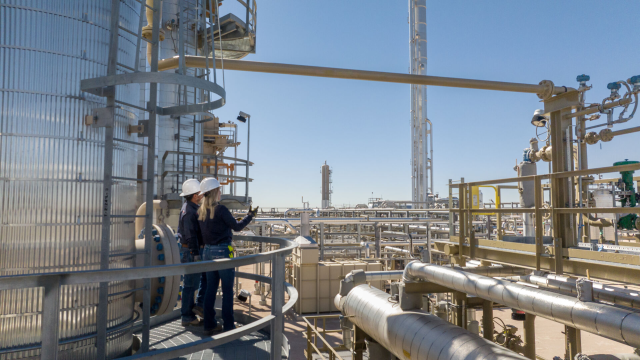
Exxon Mobil Corp. boosted oil and gas output from the Permian Basin to new heights during the first quarter. And the company is on the lookout for new M&A opportunities even as it looks to divest about $15 billion in assets. (Source: Exxon)
Exxon Mobil Corp. boosted oil and gas output from the Permian Basin to new heights during the first quarter. And the company is on the lookout for new M&A opportunities even as it looks to divest about $15 billion in assets.
Exxon’s Permian production reached a quarterly record net volume of 615,000 barrels of oil equivalent per day (boe/d) during the three months ended March 31, the oil and gas supermajor reported in first-quarter earnings on April 28.
Permian output was up nearly 10% from fourth-quarter 2022, when Exxon delivered then-record quarterly production of more than 560,000 boe/d.
Exxon anticipates growing net Permian production by about 10% for the full year. The company aims to boost Permian oil and gas output to 1 MMboe/d by the end of 2027.
“I think we’ve said in the past that as you look at production in the Permian, it’s going to be a little bit lumpy,” said Darren Woods, chairman and CEO at Exxon, in an April 28 earnings call with analysts. “I wouldn’t take any one data point, any one quarter’s numbers and extrapolate from there. I think you’re going to see some moving on that up and down.”
RELATED: Molecular Transformation: Exxon Mobil Tackles the Energy Transition
Generally, Woods said, Exxon is pleased with well productivity in the Permian. For several years, the company has worked to develop and fine-tune a cube design strategy to work across multiple benches simultaneously and maximize oil recovery.
RELATED: Will Cube Development Square with Producers?
Company-wide net production in the first quarter was 3.8 MMboe/d, up nearly 160,000 boe/d compared to the same quarter last year.
Excluding divestments, entitlements and the expropriation of the Sakhalin-1 project in eastern Russia, Exxon’s net production rose by nearly 300,000 boe/d due to output gains in the Permian and Guyana.
RELATED: Exxon Mobil Pumps Brakes on Projected Permian Basin Growth
Potential for Permian M&A
Exxon started to clear its DUC inventory in the Permian by bringing those wells into production as commodity prices rose as much of the world emerged from the COVID-19 pandemic, the company said in fourth-quarter earnings in January.
In addition to growing production from Permian wells this year, Exxon also has laid out a goal to replenish its inventory of DUC wells in the Lower 48’s premier shale play.
Exxon isn’t alone in looking for inventory runway in the Permian. Several large publics, including Ovintiv Inc., Matador Resources and Diamondback Energy, spent billions of dollars signing deals to acquire private E&Ps with Permian positions in the past year.
Flush with cash from outsized profits earned in the past year, Exxon is reportedly eyeing Permian dealmaking of its own: The company has held preliminary discussions on potential M&A with Permian pure-play Pioneer Natural Resources, the Wall Street Journal reported in early April.
Exxon has previously told Hart Energy in an email they would not comment on market rumors or speculation.
RELATED: Pioneer Megamerger Could Cost Exxon Mobil $70 Billion
Pioneer has itself been the subject of recent rumors as both acquirer of Range Resources — which the company denied — and as a potential target for Exxon. During its April 27 earnings call, Pioneer steadfastly refused to comment on any potential deals with Exxon.
Woods said Exxon is always looking at opportunities for an acquisition that creates accretive value for shareholders.
“We’re not actually in the market to find volume — we’re in the market to find value,” Woods said.
While the company will consider M&A, Exxon is focusing its attention on using technology and innovation to make advances in Permian well productivity, he said.
Asset divestitures continuing
While the company will consider growth through M&A, Exxon is also streamlining its existing upstream portfolio through divestitures.
Exxon has laid out a goal to raise $15 billion from asset divestments, and Woods said the company should hit its divestiture objective sometime this year.
While Exxon is comfortable with its existing portfolio and doesn’t have to sell, Woods said he expects the company to be consistent in bringing assets to market.
“As we continue to work on high-grading the portfolio, continue to look at assets that we don’t see are strategic necessarily or see potential higher value for others, we’ll continue to feed that divestment portfolio and market those assets,” Woods said.
Recommended Reading
NAPE: Turning Orphan Wells From a Hot Mess Into a Hot Opportunity
2024-02-09 - Certain orphaned wells across the U.S. could be plugged to earn carbon credits.
Comstock Continues Wildcatting, Drops Two Legacy Haynesville Rigs
2024-02-15 - The operator is dropping two of five rigs in its legacy East Texas and northwestern Louisiana play and continuing two north of Houston.
Chevron Hunts Upside for Oil Recovery, D&C Savings with Permian Pilots
2024-02-06 - New techniques and technologies being piloted by Chevron in the Permian Basin are improving drilling and completed cycle times. Executives at the California-based major hope to eventually improve overall resource recovery from its shale portfolio.
CEO: Continental Adds Midland Basin Acreage, Explores Woodford, Barnett
2024-04-11 - Continental Resources is adding leases in Midland and Ector counties, Texas, as the private E&P hunts for drilling locations to explore. Continental is also testing deeper Barnett and Woodford intervals across its Permian footprint, CEO Doug Lawler said in an exclusive interview.
Petrobras to Step Up Exploration with $7.5B in Capex, CEO Says
2024-03-26 - Petrobras CEO Jean Paul Prates said the company is considering exploration opportunities from the Equatorial margin of South America to West Africa.





